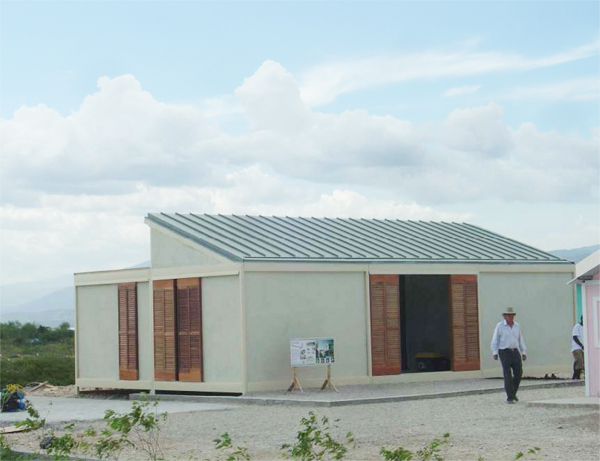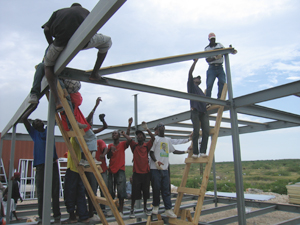 |
| Photo © Luckenbach/Ziegelman Architects |
Michigan-based Luckenbach/Ziegelman Architects is showing a six-room home made of prefabricated steel. |

A government-sponsored expo that aims to offer feasible housing ideas for earthquake-ravaged Haiti is now under way on a former sugar plantation just north of Port-au-Prince.
On three acres in the rural village of Zoranger, 60 prototypes for affordable, single-family homes are on view as part of the “Building Back Better Communities” expo, a three-month event organized by the Haitian government with help from the Clinton Foundation and other entities. The expo, which opened July 21 and runs through September, comes a year and a half after a massive earthquake devastated the impoverished, island country. An estimated 635,000 people are still in tent camps.
The expo stems from a design competition launched last fall that drew 400 submissions from a varied pool, including architects, housing manufacturers, universities, and nonprofit groups. Organizers selected a round of finalists in January 2011, and then winnowed the list down to the expo participants. The participants are covering transport and installation costs.
Michigan-based Luckenbach/Ziegelman Architects is one of the few U.S. firms showing a prototype at the expo. “It’s been a long process, but I feel great that we’ve been included,” says Bob Ziegelman, founding principal.
At the expo’s conclusion, government officials will announce which designs they want to replicate on an adjacent nine-acre site. The area will be transformed into a permanent, 400-home village, dubbed the “exemplar housing settlement.” The InterAmerican Development Bank plans to cover its $30 million construction costs.
The original design requirements stipulated that structures range from 300 to 700 square feet; be made of steel, concrete and wood; and be sturdy enough to withstand earthquakes and hurricanes. They also needed to cost less than $35,000 to construct.
But some designers strayed from the initial guidelines. Ziegelman, for instance, is showing a six-room home made of prefabricated steel. “Mine is definitely more middle-class housing,” he says. His structures cost $60,000 if produced alone but much less if produced in bulk. He once designed similar structures for use as hospitals in earthquake-torn Guatemala.
While some housing designs don’t refer to Haiti’s vernacular architecture, others tried to incorporate local styles and elements. The windows on a home by New York-based Aarris Architects feature security bars configured to resemble symbols in West Africa, the ancestral home of many Haitians. “My heart has always been in Haiti,” says firm president Nicole Hollant-Denis, whose father was born in the country.
Given various stumbling blocks in the past year, it’s remarkable that the expo is actually up and running. The event was originally scheduled for October 2010, though government officials postponed it until after the country’s national elections, which took place last November.
Moreover, many entrants dropped out of the competition, turned off by delays and guideline changes. Rodney Leon, a New York architect who made the initial cut but withdrew in May, said he grew frustrated by the fact that organizers refused to emphasize the use of local building materials. Since then, Leon has submitted his own housing prototype to the Haitian government.
In the competition’s defense, John McAslan, founding principal of the London-based John McAslan + Partners, an organizer, said allowing different types of materials resulted in a better crop. “It’s much richer and much more varied,” he says.

Post a comment to this article
Report Abusive Comment